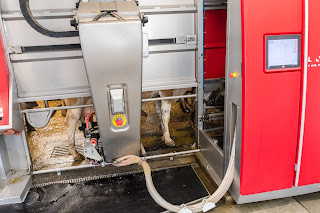Communications
 |
| A robotic milker stops milking and starts to detach from the udder |
You may remember the milk commercials from California –
great milk comes from happy cows. However, happy cows don’t just come from
California. Washington dairy farmers have long known this secret and
continually find new ways to make their cows even happier.
Sometimes happier cows come from unexpected changes. We
recently visited Twin Brook Creamery and learned how their dairy has changed
over the years. One of the changes they mentioned was switching to robotic milking,
with surprising benefits for both the cows and the farmer.
Robotic milking allows for automated milking of cows at any
time of day. A stall is set up where the cows walk in as they wish. She gets a
snack while a machine cleans her udder then uses lasers to attach the milking
apparatus udder to milk the cow. There are many benefits for the cows:
- Milking on (the cow’s) demand - The robotic milking stalls are available all the time, so the cow gets milked on the schedule she chooses, rather than on the farmer’s schedule.
- Milking frequency - Some cows may choose to be milked three times a day, which puts less stress on the udder and improves comfort for the cow.
- Lower stress – Rather than having to be rounded up twice a day and herded back into the milking parlor, the cows come and go as they choose.
- Health checks – The robotic milker can detect issues in the milk that may indicate a health issue with the cow even before she shows signs of illness.
 |
| A cow being milked by a robotic milker |
But the cows aren’t the only winners here. Farmers benefit as well:
- Reduced labor – While labor is still required (the robotic milker will send cell phone alerts 24/7 if there is a problem) the overall time commitment for milking is greatly diminished. The farmer isn’t obliged to go to the milking parlor for hours twice a day, 365 days a year.
- Squeaky clean – Prior to milking, the robotic sensor cleans and sanitizes both the udder and teat, keeping the cow and milking surfaces clean and sanitary. While farmers do this as well, the robotic system can reduce any human error factors.
- No kicks – When milking by hand, the risk exists for the cow to kick the dairy farmer while milking, given how close they necessarily have to be to a cow’s hind legs. The hands-off system eliminates that risk.
While robotic milking is expensive to start and isn’t for
every dairy, it is a great example of the diverse ways that dairy farmers are
working to constantly improve their operations for not only themselves, but
their cows as well.
Below is a video that shows a farm getting started with robotic milking.
Below is a video that shows a farm getting started with robotic milking.
